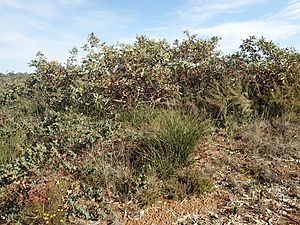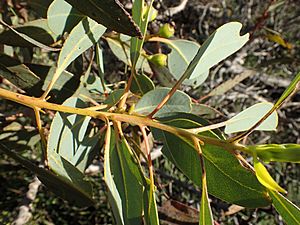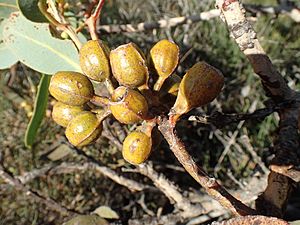Eastern tallerack facts for kids
Quick facts for kids Eastern tallerack |
|
|---|---|
 |
|
| Eucalyptus extrica | |
| Scientific classification | |
| Genus: |
Eucalyptus
|
| Species: |
extrica
|
The Eastern Tallerack (scientific name: Eucalyptus extrica) is a special type of eucalyptus tree. It's found only in Western Australia, which means it's endemic there. This plant has smooth bark and leaves that grow in pairs. Its flowers are whitish, and its fruits look like small barrels.
Contents
What is the Eastern Tallerack?
The Eastern Tallerack is a type of mallee plant. This means it grows like a bush with many stems, usually reaching 1 to 4 meters (about 3 to 13 feet) tall. It has a special woody lump at its base called a lignotuber. This helps the plant regrow after events like bushfires.
Its bark is usually smooth and light grey, sometimes with rougher, stringy bark near the bottom of the stems.
Leaves and Flowers
Young Eastern Tallerack plants have leaves that are slightly bluish-green. This color is called glaucous. These young leaves are oval-shaped and grow in pairs.
As the plant gets older, its leaves are still arranged in opposite pairs. They are shaped like a spear or an egg, and they are a dull green color on both sides. These adult leaves are about 70 to 140 millimeters (2.7 to 5.5 inches) long and 20 to 50 millimeters (0.8 to 2 inches) wide. Each leaf has a stalk called a petiole, which is about 12 to 30 millimeters (0.5 to 1.2 inches) long.
The flower buds grow in groups of three. They are found where the leaves meet the stem. Each group of buds sits on a flattened stalk called a peduncle, which is 6 to 20 millimeters (0.2 to 0.8 inches) long. The individual buds are on smaller stalks called pedicels, about 6 to 13 millimeters (0.2 to 0.5 inches) long.
When the buds are ready to open, they are oval-shaped, about 6 to 8 millimeters (0.2 to 0.3 inches) long and 5 to 6 millimeters (0.2 inches) wide. They have a rounded cap called an operculum. The Eastern Tallerack flowers between January and April, and its flowers are whitish.
Fruit
After flowering, the plant produces woody fruits. These fruits are shaped like a cylinder or a barrel. They are about 13 to 21 millimeters (0.5 to 0.8 inches) long and 10 to 22 millimeters (0.4 to 0.9 inches) wide. The parts that open to release seeds are called valves, and they are usually near the rim of the fruit.
The Eastern Tallerack is similar to another plant called Eucalyptus pleurocarpa. However, E. pleurocarpa has shorter, wider, and more bluish-green leaves, buds, and fruits. Sometimes, you might find plants that look like a mix of both species.
How it was Named
The Eastern Tallerack was officially described in the year 2000 by a scientist named Dean Nicolle. He collected a sample of the plant near a place called Condingup. The description was published in a science journal called Nuytsia.
Nicolle chose the scientific name extrica because it comes from a Latin word meaning "disentangled" or "free." He used this name because this species was often confused with another eucalyptus, Eucalyptus tetragona, in the past. The name helps to show that it is now "free" from that confusion.
Where it Grows
The Eastern Tallerack is found in the coastal areas of the Goldfields-Esperance region in Western Australia. It grows between the town of Esperance and Cape Arid. You can find it growing in sandy soils that are often found over limestone.
Conservation Status
The Western Australian Government's Department of Parks and Wildlife has looked at the Eastern Tallerack. They have classified this mallee as "not threatened." This means that for now, there are enough of these plants in the wild, and they are not considered to be in danger.



